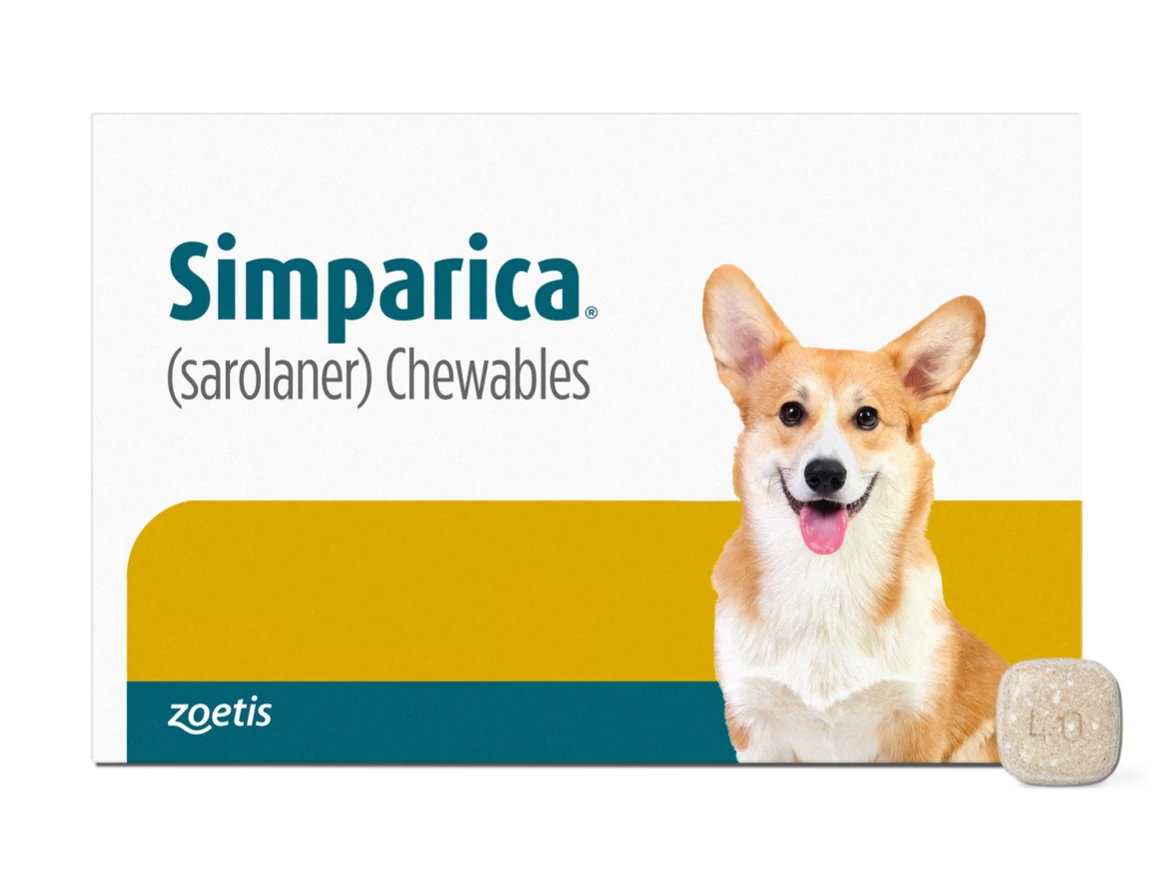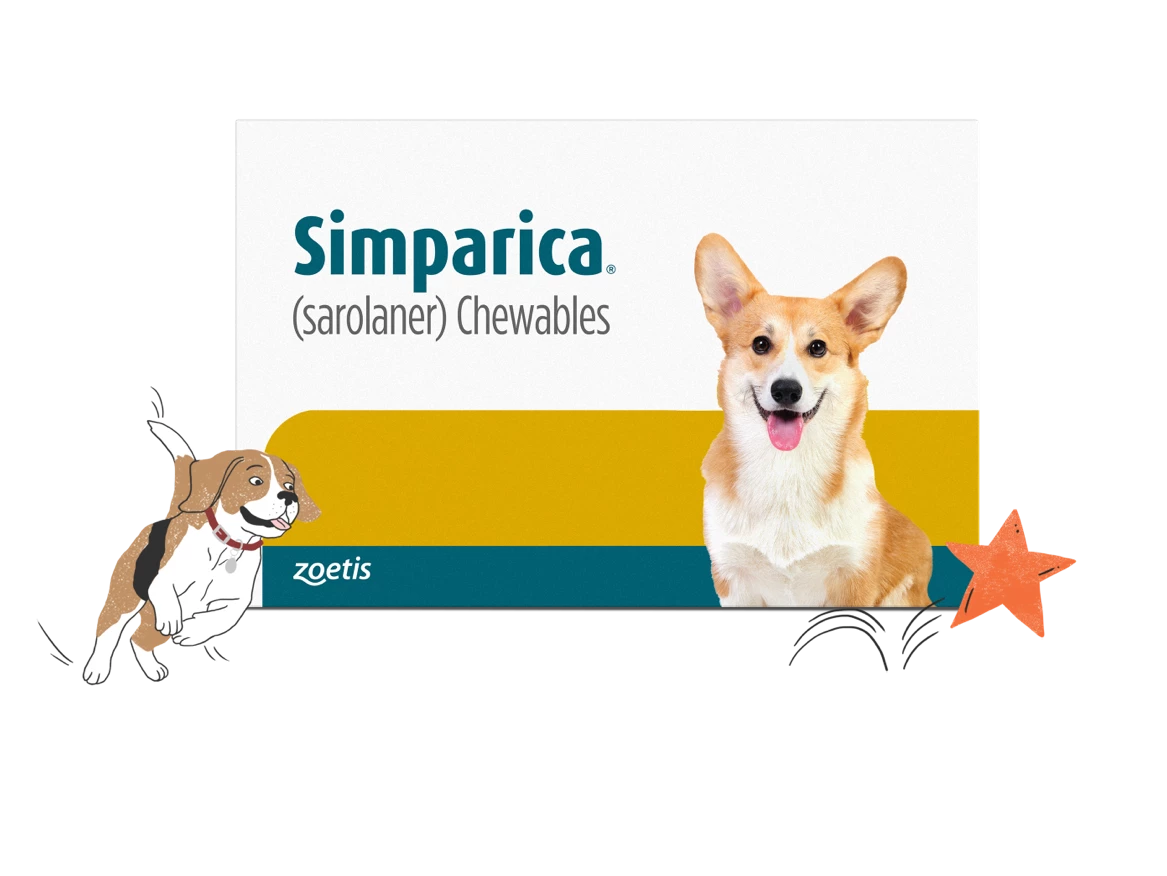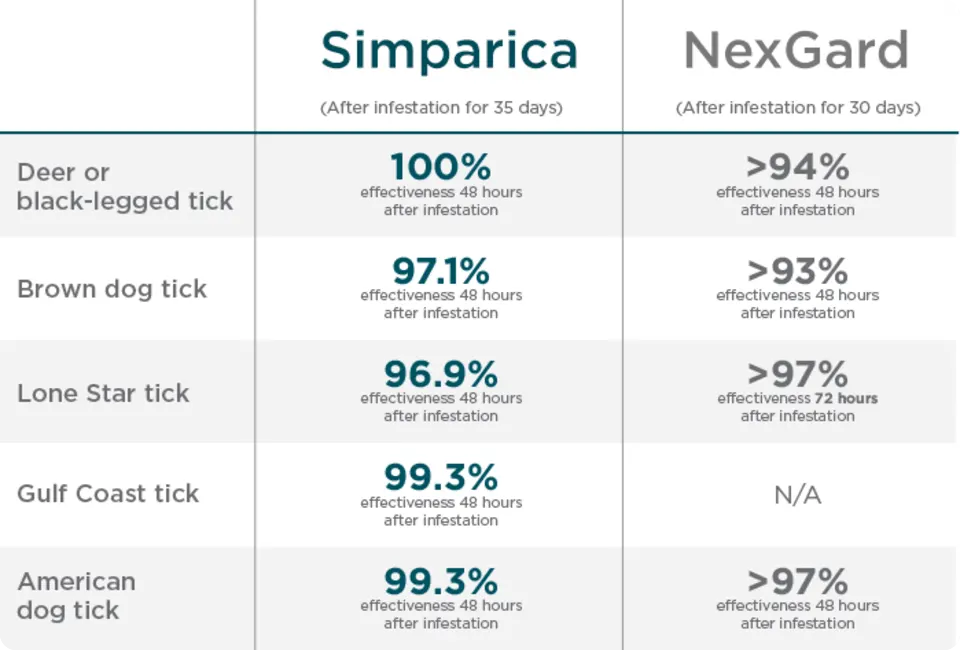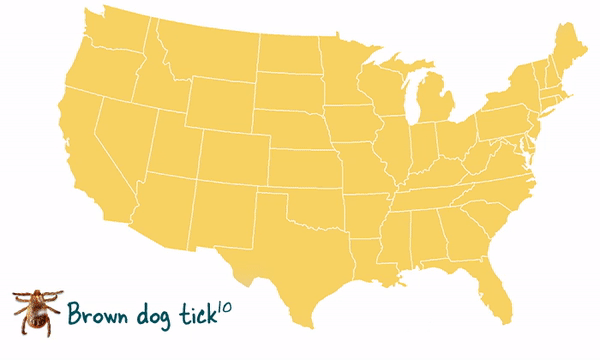
Protect Your Dog From Ticks & Fleas for 35 Days1

Simparica Starts Working Fast and Stays Strong All Month Long2-7*
Have you ever been a few days late giving your dog monthly tick and flea protection? We get it. Simparica is a monthly tick and flea chewable that gives you a few extra days of wiggle room at the end of the month.1 Rest assured that your dog is protected each month, even if you are late giving the next dose.
Earn up to $35 in Rewards from your Simparica purchase.*

Why Simparica?
- Protects dogs from ticks and fleas for 35 days.1
- Stays strong all month long, unlike some other products.2-6
- Starts killing ticks and fleas fast7*.
- The first flea and tick preventative for dogs that kills 6 types of ticks,† including the Gulf Coast tick and Asian longhorned tick.
- FDA-approved to block infections that may cause Lyme disease, by killing deer ticks.
- FDA-approved and available with a valid prescription from your vet.
- Great-tasting chewable you give your dog once a month.
- Earn up to $35 in rewards with your Simparica purchase.‡
*Studies show that Simparica starts killing fleas in 3 hours and ticks in 8 hours.7
†Lone star tick (Amblyomma americanum), Gulf Coast tick (Amblyomma maculatum), American dog tick (Dermacentor variabilis), black-legged tick (Ixodes scapularis), brown dog tick (Rhipicephalus sanguineus), and Asian longhorned tick (Haemaphysalis longicornis).
‡Program Terms and Conditions apply.

The Simparica Difference: No Dropoff in Effectiveness at the End of the Month, Unlike Some Other Products2‑6
Ticks and fleas don’t slow down at the end of the month. Your dog’s tick and flea protection shouldn’t either. Simparica starts—and stays—strong all month long.1
In a study, Simparica killed more brown dog ticks than NexGard.

Comparison of the effectiveness of Simparica and NexGard against ticks 48-72 hours after infestation9

In a study, Simparica killed more fleas than NexGard.
On day 28, NexGard performed above 90% starting at 12 hours, taking 4 more hours to match Simparica’s results. After 24 hours, NexGard caught up completely to Simparica, demonstrating 100% effectiveness at all time points.2
NexGard is a registered trademark of Boehringer Ingelheim Animal Health USA Inc., 2025.
Satisfaction Guarantee
- Fleas
- Ticks
- Lyme Disease
We want you to be 100% satisfied with Simparica. We’ll work with you to make sure you’re satisfied with Simparica’s performance. If for any reason you’re still not completely happy, we’ll send you a replacement or give you your money back. Simply give us a call at 1‑888‑ZOETIS1 and we’ll take care of you.
Ticks and Fleas — Small Pests, Big Problem
Ticks and fleas can bug your dog year-round.10 Some can even put your dog’s health in danger.11
- Ticks can be found anywhere in the US and at any time of year10
- It just takes 1 infected tick to spread disease that can be harmful, even deadly, to dogs12,13
- Some ticks can survive freezing temperatures and become active when the temperature rises to 40°F14,15
Simparica is the FIRST flea and tick preventative for dogs that kills 6 types of ticks and starts working fast* and goes strong for 35 days.1 Simparica is FDA-approved to block infections that may cause Lyme disease, by killing deer ticks.
Ticks are a growing problem

*Studies show that Simparica starts killing fleas in 3 hours and ticks in 8 hours.7
- Where there’s one flea, there can be hundreds more
- It only takes 1 “pregnant” flea to infest your dog or home
- Fleas can carry diseases that make your dog sick
- Some dogs are allergic to fleas, and symptoms like skin inflammation, hair loss, and sores can make dogs miserable16
Monthly Simparica starts killing fleas fast* (before they can lay eggs), and it goes strong for 35 days. Simparica provides much-needed, fast relief for dogs with fleas and dogs with flea allergies.
Protect your home from fleas.
*Studies show that Simparica starts killing fleas in 3 hours and ticks in 8 hours.7
Remind Me About Simparica Dosing
To make sure your dog is always protected from ticks and fleas, it’s important to give your dog their tasty Simparica chewable at the same time every month. We offer free monthly reminder emails and/or text messages to help you remember when it’s time for the next dose.
Lyme Infections, Hard to Diagnose, Effective Prevention Available
If your dog is bitten by a deer tick they are at risk for the infection that causes Lyme disease, which can cause recurring health problems like arthritis or kidney failure.17
Lyme disease can take time to diagnose and treat, causing further problems for dogs who are infected.
The good news is Simparica kills deer ticks fast,7† and is FDA-approved to block infections that may cause Lyme disease, by killing deer ticks.
†Studies show that Simparica starts killing fleas in 3 hours and ticks in 8 hours.7
Frequently Asked Questions
See the Simparica Difference:
- The first flea and tick preventative for dogs that kills 6 types of ticks,† including the Gulf Coast tick.
- No dropoff in effectiveness at the end of the month, unlike some other products2-6
† Lone star tick (Amblyomma americanum), Gulf Coast tick (Amblyomma maculatum), American dog tick (Dermacentor variabilis), black-legged tick (Ixodes scapularis), brown dog tick (Rhipicephalus sanguineus), and Asian longhorned tick (Haemaphysalis longicornis).
Give a Simparica chewable to your dog once a month.
Simparica is a monthly chewable that starts protecting in hours* and lasts for 35 days.1 That gives you a little wiggle room at the end of the month, in case you’re late with the next month’s dose.
Simparica starts killing ticks and fleas fast. Simparica starts killing fleas within 3 hours and ticks within 8 hours.7
Simparica is the first flea and tick preventative for dogs that kills 6 types of ticks, including the Gulf Coast tick:
Lone Star Tick
- Gulf Coast Tick
American Dog Tick
Deer Tick/Black-Legged Tick
Brown Dog Tick
Asian Longhorned Tick
Yes, Simparica is FDA-approved to prevent infections that may cause Lyme disease, by killing deer ticks.
Rest assured, Simparica is a monthly chewable that protects your dog for 35 days.1 That means you have a little wiggle room at the end of the month. If you have questions about dosing, talk to your vet.
We understand it can be hard to stay on top of your dog’s dosing schedule. That’s why we offer free monthly reminder emails and/or text messages.
No, unlike some other treatments, Simparica can be given with or without food.
Yes, Simparica is available only by prescription from your vet. Talk to your vet today about Simparica.
Zoetis Petcare Rewards is a program designed to help you save on pet care at your vet.‡ Whenever you purchase an eligible Simparica product, you can submit an invoice to earn points. Points can be redeemed for a Zoetis Petcare Rewards Card to use at your vet for any product or service.
We want you to be completely satisfied with Simparica. We’ll work with you to make sure you’re satisfied with Simparica’s performance. If for any reason you’re still not completely happy, we’ll send you a replacement or give you your money back. Simply give us a call at 1‑888‑ZOETIS1 and we’ll take care of you.
IMPORTANT SAFETY INFORMATION: See full Prescribing Information. Simparica is for use only in dogs 6 months of age and older. Simparica, which contains sarolaner, a member of the isoxazoline class, may cause neurologic signs such as tremors, unsteadiness and/or seizures in dogs with or without a history of neurologic disorders. Simparica has not been evaluated in pregnant, breeding, or lactating dogs. The most common adverse reactions in clinical trials were vomiting and diarrhea.
*Studies show that Simparica starts killing fleas in 3 hours and ticks in 8 hours.7
†Lone star tick (Amblyomma americanum), Gulf Coast tick (Amblyomma maculatum), American dog tick (Dermacentor variabilis), black-legged tick (Ixodes scapularis), brown dog tick (Rhipicephalus sanguineus), and Asian longhorned tick (Haemaphysalis longicornis).
‡Program Terms and Conditions apply.
References:- Six RH, Everett WR, Young DR, et al. Efficacy of a novel oral formulation of sarolaner (Simparica®) against five common tick species infesting dogs in the United States. Vet Parasitol. 2016;222:28-32.
- Six RH, Liebenberg J, Honsberger NA, Mahabir SP. Comparative speed of kill of sarolaner (Simparica®) and afoxolaner (NexGard®) against induced infestations of Ctenocephalides felis on dogs. Parasit Vectors. 2016;9:90.
- Six RH, Young DR, Holzmer SJ, Mahabir SP. Comparative speed of kill of sarolaner (Simparica®) and afoxolaner (NexGard®) against induced infestations of Rhipicephalus sanguineus s.l. on dogs. Parasit Vectors. 2016;9:91.
- Six RH, Liebenberg J, Honsberger NA, Mahabir SP. Comparative speed of kill of sarolaner (Simparica®) and fluralaner (Bravecto®) against induced infestations of Ctenocephalides felis on dogs. Parasit Vectors. 2016;9:92.
- Becskei C, Geurden T, Liebenberg J, Cuppens O, Mahabir SP, Six RH. Comparative speed of kill of oral treatments with Simparica® (sarolaner) and Bravecto® (fluralaner) against induced infestations of Rhipicephalus sanguineus on dogs. Parasit Vectors. 2016;9:103.
- Six RH, Everett WR, Myers MR, Mahabir SP. Comparative speed of kill of sarolaner (Simparica®) and spinosad plus milbemycin oxime (Trifexis®) against induced infestations of Ctenocephalides felis on dogs. Parasit Vectors. 2016;9:93.
- Six RH, Geurden T, Carter L, et al. Evaluation of the speed of kill of sarolaner (Simparica®) against induced infestations of three species of ticks (Amblyomma maculatum, Ixodes scapularis, Ixodes ricinus) on dogs. Vet Parasitol. 2016;222:37-42.
- Honsberger NA, Six RH, Heinz TJ, et al. Efficacy of sarolaner in the prevention of Borrelia burgdorferi and Anaplasma phagocytophilum transmission from infected Ixodes scapularis to dogs. Vet Parasitol. 2016;222:67-72.
- Boehringer Ingelheim NexGard Package Insert Competitor Information (v2.0). Accessed January 22, 2025.
- Centers for Disease Control and Prevention. Geographic distribution of ticks that bite humans. http://www.cdc.gov/ticks/geographic_distribution.html. Updated June 1, 2015. Accessed January 22, 2025.
- Blagburn BL, Dryden MW. Biology, treatment, and control of flea and tick infestations. Vet Clin Small Anim. 2009;39(6):1173-1200.
- How ticks spread disease. Centers for Disease Control and Prevention website. https://www.cdc.gov/ticks/life_cycle_and_hosts.html. Updated January 10, 2019. Accessed January 22, 2025.
- Little SE. Changing paradigms in understanding transmission of canine tick-borne diseases: the role of interrupted feeding and intrastadial transmission. In: Proceedings of the 2nd Canine Vector-Borne Disease (CVBD) Symposium; April 25-28, 2007; Sicily, Italy.
- Fleas, ticks & your pet. Companion Animal Parasite Council (CAPC) website. http://www.petsandparasites.org/images/uploads/documents/BC-3844_CAPC_FleaTick_one-color_04.pdf. Updated March 2011. Accessed January 22, 2025.
- Ticks: What are the risks in northern New England? University of Vermont Medical Center website. https://medcenterblog.uvmhealth.org/infectious-disease/ticks-northern-new-england. Updated August 23, 2018. Accessed January 22, 2025.
- Flea Allergy Dermatitis in Cats and Dogs. Vet Street website. http://www.vetstreet.com/care/flea-allergy-dermatitis-in-cats-and-dogs. Updated April 22, 2014. Accessed January 22, 2025.
- Lyme Disease. CDC. https://www.cdc.gov/ticks/tickbornediseases/lyme.html. Accessed January 22, 2025.









